Modeling the World from
Internet Photo Collections
利用互联网图片集对世界进行建模
�
Modeling the World from Internet Photo Collections
Noah Snavely ·Steven M. Seitz ·Richard Szeliski
• Abstract
• 1 Introduction
• 2 Previous Work
• 3 Overview
• 4 Reconstructing Cameras and Sparse Geometry
• 5 Photo Explorer Rendering
• 6 Photo Explorer Navigation
• 7 Enhancing Scene
• 8 Results
• 9 Research Challenges
�
Abstract & Introduction
Main point : Using structure-from-motion and image-based
rendering algorithms to operate images downloaded from the
Internet ,and reconstructing world sites.
(核心:从网络图片实现世界的三维重建)
Major challenge: the images are unorganized, uncalibrated,
with widely variable illumination, resolution, and image quality.
(主要挑战:网络图片质量参差不齐)
�
2 Previous Work
2.1 Feature Correspondence-特征匹配
•
“corner-like” feature points, Harris feature points等特征;
本文采用:SIFT特征,因其优越的尺度不变性
2.2 Structure from Motion-稀疏重建
•
在Lowe 2005提出的 SfM 基础上做了四点改变:
姿态估计初始化相机参数,启发式规则选择初始图像,检验重构点优良性,从EXIF中计算焦距
2.3 Image-Based Modeling-基于图像建模
•
稀疏重建、基于模型重建等计算机视觉技术,研究成果众多,其又被称为 基于图像的建模 方法。
本文强调creating smooth 3D transitions between photographs 而不是interactively visualizing a 3D world。
2.4 Image-Based Rendering-基于图像渲染
•
本文避开IRB技术的核心:重建逼真的物体表面,光照问题、精确像素插值问题
这使文章能够不受IBM与IBR方法的限制,更自由地操作输入图片。
2.5 Image Browsing, Retrieval, and Annotation搜集图片
•
检索技术: Video Google 的三维扩展版本
注释技术:能使得注释在不同图片之间迁移
�
3 Overview
(此部分为文章脉络概述)
• 本文主要目标:geometrically register large photo collections from the Internet and other
sources
• 主要困难:网络图形对于建模的不友好性,质量问题
• 主要解决方法:特征匹配和稀疏重建
• 第四部分:详细叙述本文建模方法
• 第五部分:如何得到一个相对完美的物体表面
• 第六部分:photo explorer接口,用于用户输入图片后三维场景重建
• 第七部分:标注在多张图片中转移的技术
• 第八部分:11个场景的建模效果展示
• 第九部分:研究团队遇到的挑战性问题
�
4 Reconstructing Cameras and Sparse Geometry
相机标定与稀疏重建
• 4.1Keypoint Detection and Matching(关键点检测和匹配)
• 4.2 Structure from Motion(稀疏重建)
• 4.3 Geo-Registration(确定相机的绝对坐标)
• 4.4 Scene Representation(场景模型表达)
�
4 Reconstructing Cameras and Sparse Geometry
相机标定与稀疏重建
• 4.1Keypoint Detection and Matching(关键点检测和匹配)
Step1 检测每一张图片中的SIFT特征
Step2 ANN算用于匹配图片对(I,J)之间的特征,通过比值测试确定相匹配的特征
d
1
d
2
0.6
Step3 去除不合格匹配点: RANSAC算法计算两视图几何中的基本矩阵F得到最大候
选匹配集合,每次迭代利用八点法计算F,F矩阵的8个参数由 Levenberg-Marquardt
algorithm进行优化(捆绑调整)。
Step4 连接多张图片之间的匹配点,构成图像连通轨
Step5 由图像连通轨构造图像连通集合
�
4 Reconstructing Cameras and Sparse Geometry
相机标定与稀疏重建
4.1Keypoint Detection and Matching(关键点检测和匹配)
•
Step3 RANSAC算法:排除外点的数据,重新拟合模型,得到最大一致集合
1. 确定求解模型M,所需要的最小数据点的个数n。由n个数据点组成的子集称为模型M的一个样本;
2. 从数据点集D中随机地抽取一个样本J,由该样本计算模型的一个实例(),确定与()之间几何
距离< 阈值 t 的数据点所构成的集合,并记为S(()) ,称为实例()的一致集;
3. 如果在一致集S(())中数据点的个数# S(()) >阈值T, 则用S(())重新估计模型M,并输出结
果;如果# S(()) <阈值T,返回到步骤2;
4. 经过K次随机抽样,选择最大的一致集S(()) ,用S(())重新估计模型M,并输出结果。
�
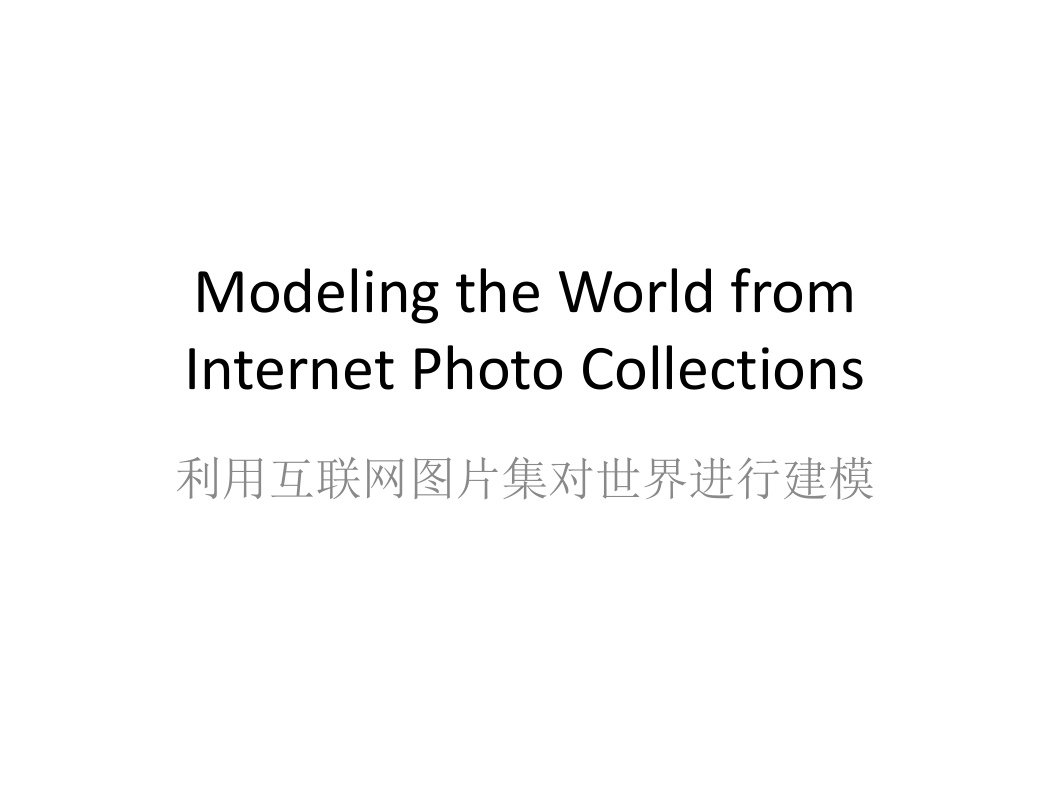
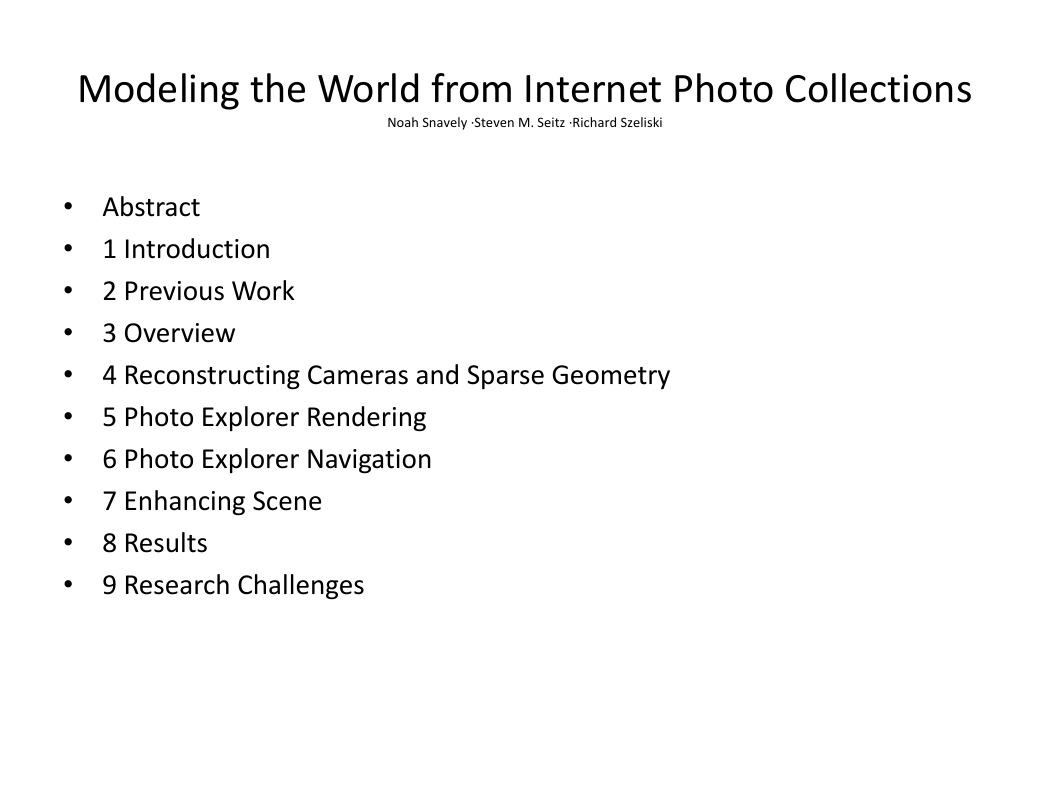
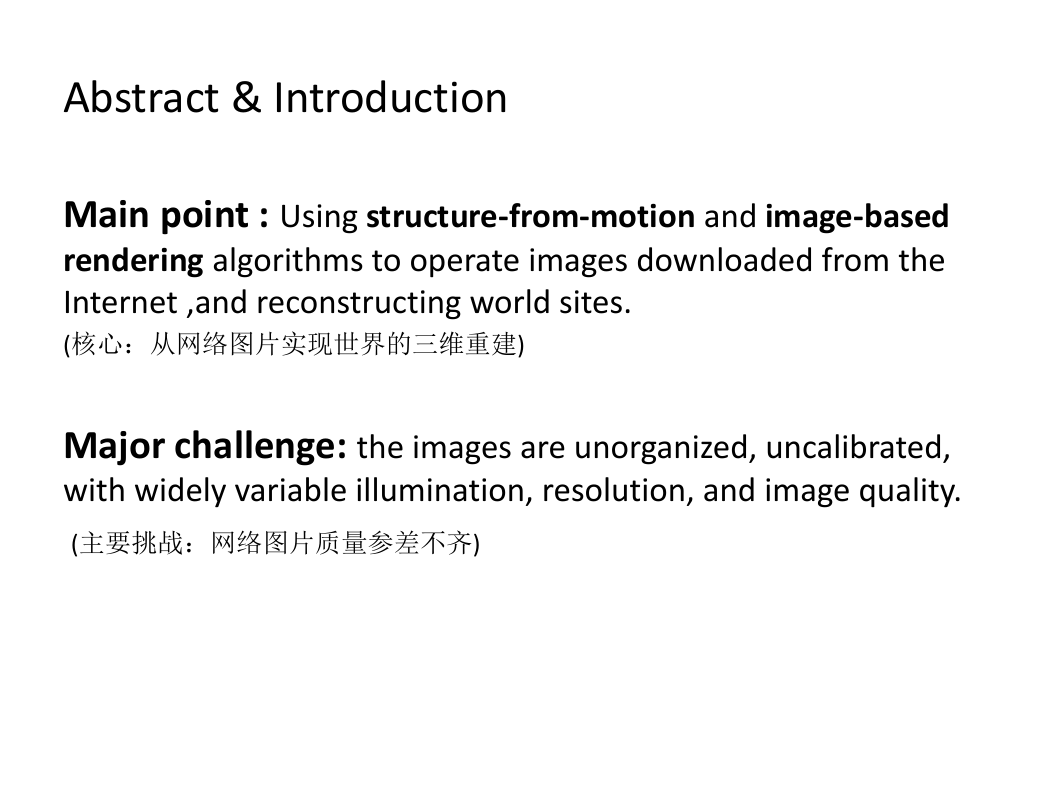

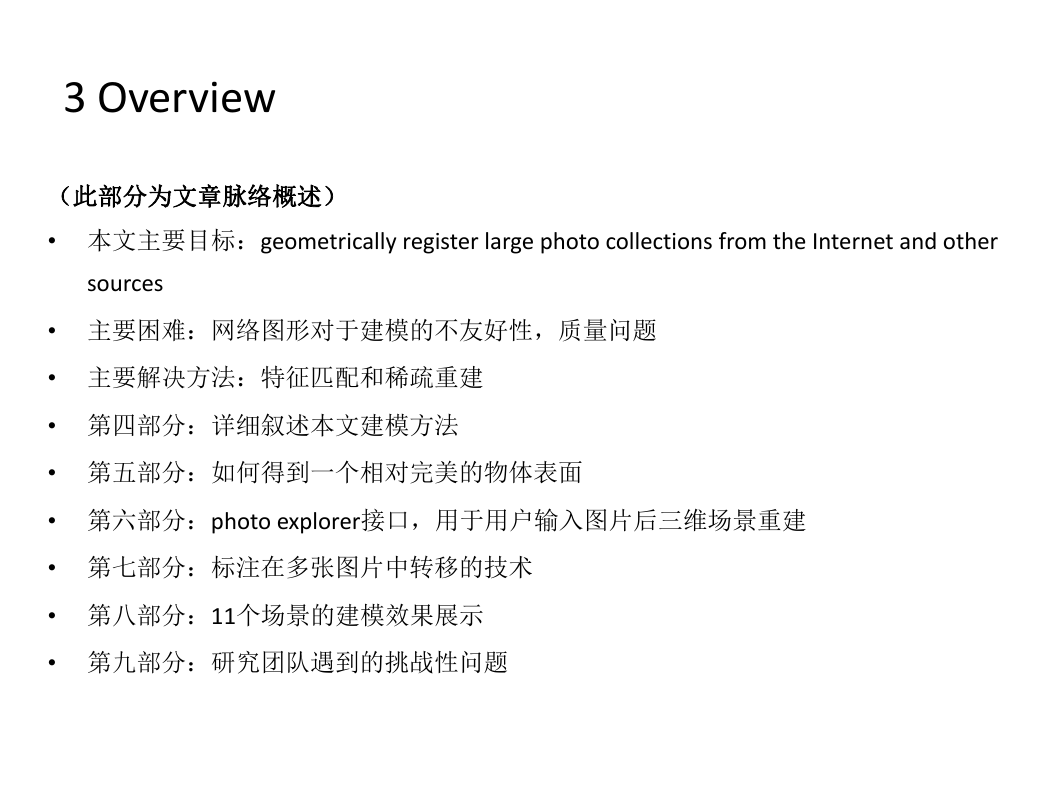
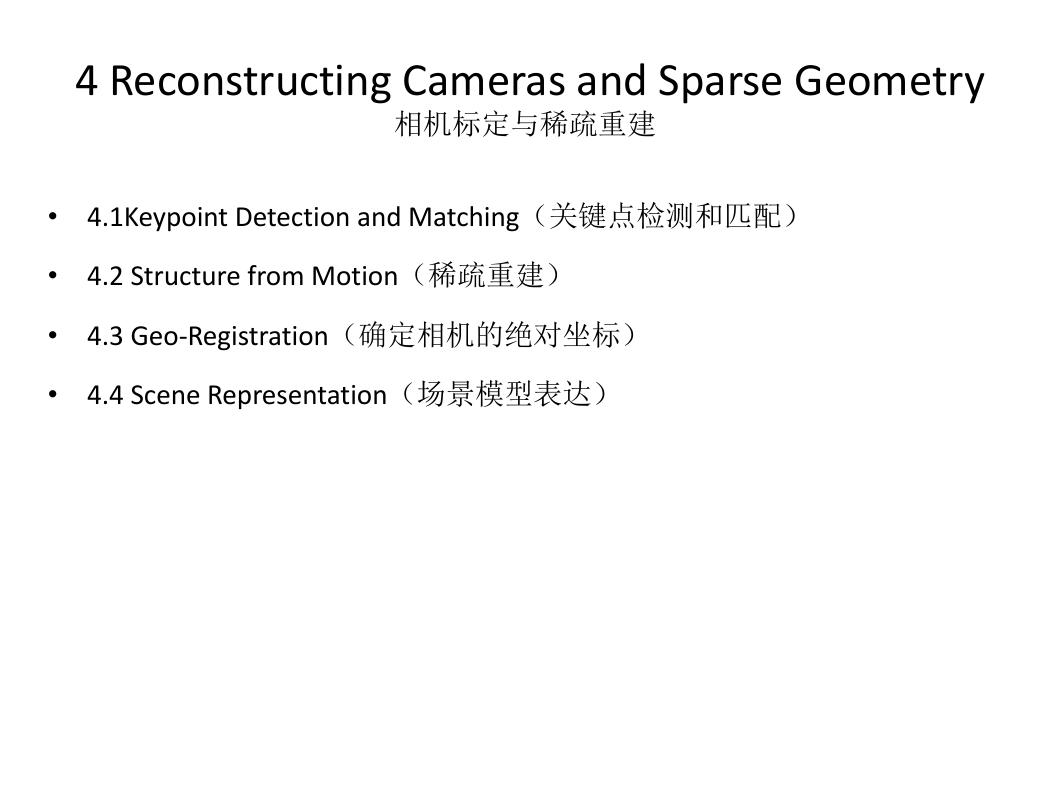
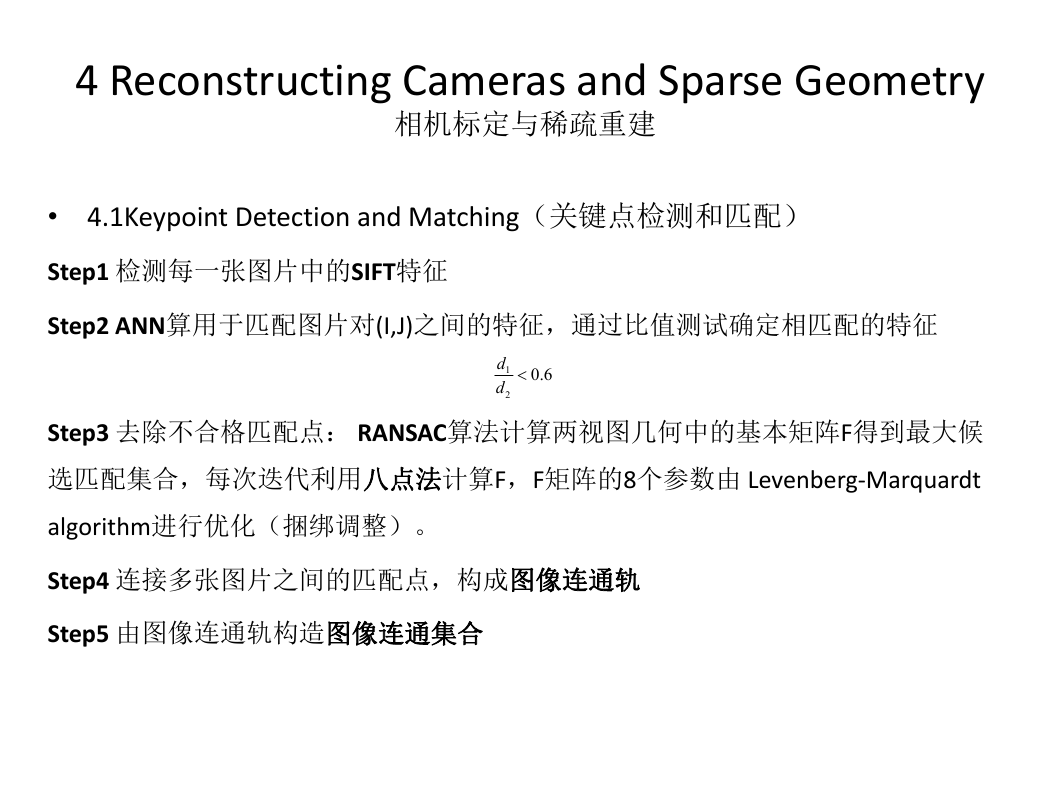
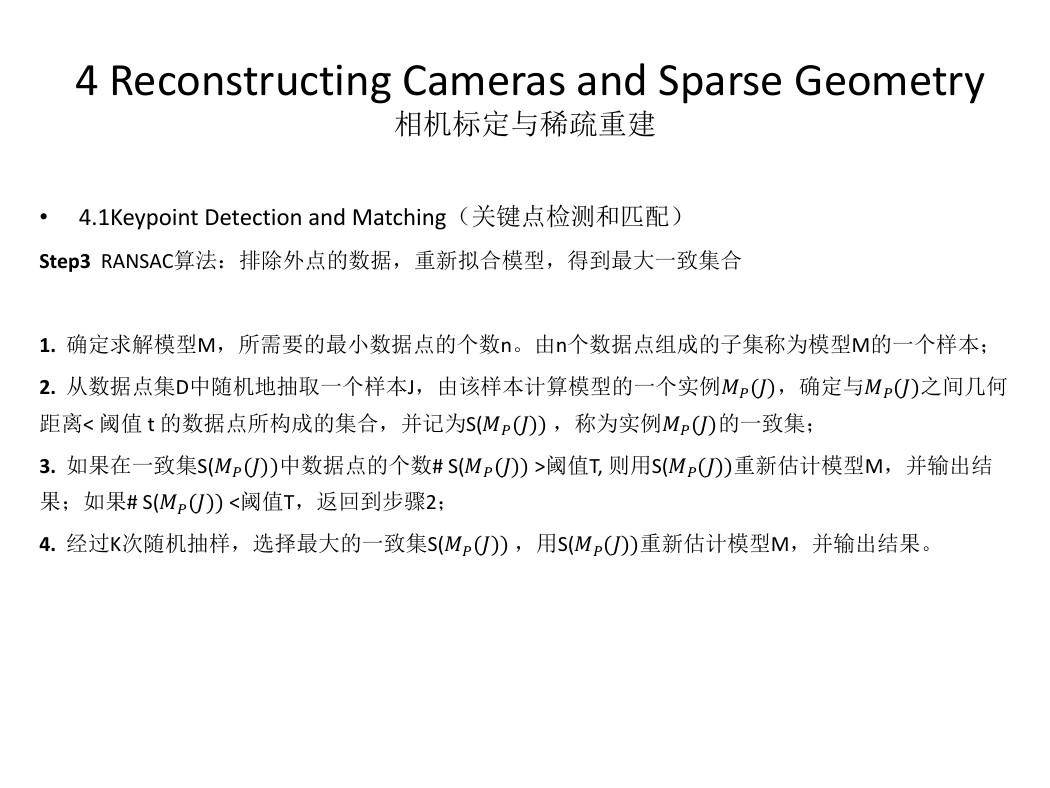








 2023年江西萍乡中考道德与法治真题及答案.doc
2023年江西萍乡中考道德与法治真题及答案.doc 2012年重庆南川中考生物真题及答案.doc
2012年重庆南川中考生物真题及答案.doc 2013年江西师范大学地理学综合及文艺理论基础考研真题.doc
2013年江西师范大学地理学综合及文艺理论基础考研真题.doc 2020年四川甘孜小升初语文真题及答案I卷.doc
2020年四川甘孜小升初语文真题及答案I卷.doc 2020年注册岩土工程师专业基础考试真题及答案.doc
2020年注册岩土工程师专业基础考试真题及答案.doc 2023-2024学年福建省厦门市九年级上学期数学月考试题及答案.doc
2023-2024学年福建省厦门市九年级上学期数学月考试题及答案.doc 2021-2022学年辽宁省沈阳市大东区九年级上学期语文期末试题及答案.doc
2021-2022学年辽宁省沈阳市大东区九年级上学期语文期末试题及答案.doc 2022-2023学年北京东城区初三第一学期物理期末试卷及答案.doc
2022-2023学年北京东城区初三第一学期物理期末试卷及答案.doc 2018上半年江西教师资格初中地理学科知识与教学能力真题及答案.doc
2018上半年江西教师资格初中地理学科知识与教学能力真题及答案.doc 2012年河北国家公务员申论考试真题及答案-省级.doc
2012年河北国家公务员申论考试真题及答案-省级.doc 2020-2021学年江苏省扬州市江都区邵樊片九年级上学期数学第一次质量检测试题及答案.doc
2020-2021学年江苏省扬州市江都区邵樊片九年级上学期数学第一次质量检测试题及答案.doc 2022下半年黑龙江教师资格证中学综合素质真题及答案.doc
2022下半年黑龙江教师资格证中学综合素质真题及答案.doc